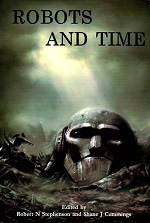The Destruction of Sennacherib
- by Bryn Sparks
- Short Story
- Science Fiction
- Adults
- Definite Time Travel
- English
- “The Destruction of Sennacherib” by Bryn Sparks, in Robots and Time, edited by Shane Jiraiya Cummings and Robert N. Stephenson (Altair Australia, 2005).
Lady Ada Lovelace, who has traveled through time via a Wells-type machine in a steampunk world, tells her story to an enamored compatriot who is 50 years older than when they last shared a conversation.
It seemed the original analytical engine, the mechanical computer designed and built by my friend and mentor, the great Charles Babbage in the 1830s, had a lethal configuration that could lock up an entire engine if it were ever presented with the right sequence of calculations. The article went on to describe how all the miniaturized analytical engines at the heart of the empire’s technology were just small versions of the original analytical engine. No one had ever changed the fundamental arrangement of cogs and gears and drive trains and clutches. They had just been made smaller and linked together in greater numbers, so here at the turn of the century, I could be driven in a cab by a man whose very thoughts were determined by the workings of beings of microscopic versions of Babbage’s original design, all operating in parallel.

Variants
(1)
- “The Destruction of Sennacherib” by Bryn Sparks, in Robots and Time, edited by Shane Jiraiya Cummings and Robert N. Stephenson (Altair Australia, 2005).
